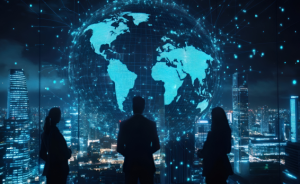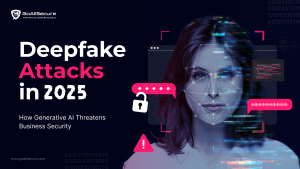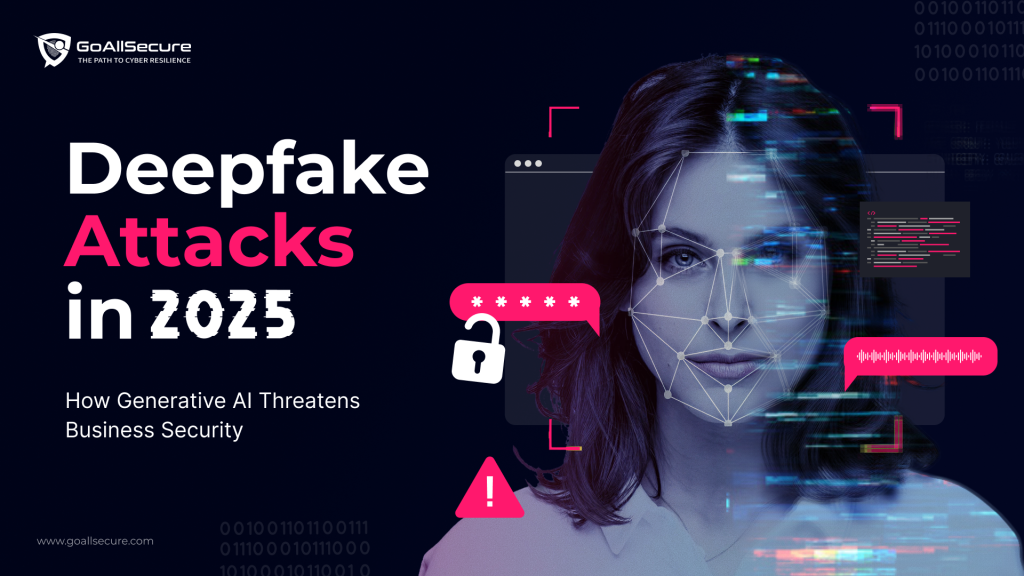As we get closer to 2026, it gets harder to determine what’s real and what’s not. AI has gotten a lot better at generating videos, voices, and visuals that look real. This is how “deepfakes” first came about. At first, people built deepfake technology only for fun and to learn more about it. But today, it’s a powerful and potentially dangerous tool that can be used to deceive, control, and steal from people.
AI can now produce almost flawless audio and video duplicates of actual people. This is a new degree of threat to cybersecurity. People in charge of businesses, cybersecurity specialists, and even the government are all quite frightened about what used to be a pleasant activity on social media or in digital art. More and more people are using deepfake technology, resulting in an increased number of cyberattacks. Generative AI is a direct threat to the safety, reputation, and integrity of organisations in 2025. In this blog, we will talk about deepfake technology and its impact on the real world. We will also discuss various ways to combat the rapidly increasing threats of generative AI.
What Are Deepfakes, and How Have They Changed Over the Years?
Deepfakes are fake videos, pictures, or any other type of media that is made using deep learning algorithms, most often Generative Adversarial Networks (GANs). They can convincingly replicate how someone talks, looks, and acts. There was a time when only professionals could realistically portray someone else in a movie, and they had to pay a lot of money for the software to do it. The advancement in generative AI models and open-source tools has provided almost anyone with access to such technology. Today, even people who don’t have a lot of money can make deepfakes in real time. These deepfakes can be trained with a short audio or video clip and sent through a lot of different channels without anyone noticing.
It’s not all bad all the time; synthetic media has proven to be a great assistance. It helps with a lot of things, like making technology easier to use, teaching, creating movies, and gaming. Having said that, the technology has also made it easier for fraud, identity theft, false information, and social engineering attempts to occur.
Deepfake Threats: Cybersecurity’s Newest Challenge
Cybercriminals aren’t simply talking about spreading and using fake news anymore. Criminals are utilising AI-generated content to deceive people, break into networks, and steal personal information. One of the worst things that happened in 2025 was the rise of Business Email Compromise (BEC) and CEO fraud, both of which leveraged deepfakes. Cybercriminals utilise deepfake audio or video calls that appear like C-level executives to fool finance departments into paying money quickly, changing account details, or giving out private information. These attacks exploit people’s trust in the corporate hierarchy to bypass standard security measures. This is because the person on the other end of the phone sounds and seems real. It’s hard to tell when someone is using a deepfake to act like someone else, especially if you’re busy or worried. This is not the same as phishing emails, which usually feature terrible grammar or an erroneous name for the website.
The question today is whether deepfakes are a brilliant new idea or another way to trick people? Looking at the current scenario, deepfakes are at a crossroads! It no doubt has the potential to be a great new technology, but it’s escalating towards becoming a way to trick people. For the creative industries, like movies, games, and virtual reality, they open up exciting new possibilities. But we can’t overlook the fact that they are being used to distribute false information or harmful content, too.
How Deepfakes Affect Society?
Deepfakes are a big problem for the truth and trust that hold society together. Their ability to make believable bogus stories has made worries about misleading information even worse, especially in areas that are important, like politics and public opinion. Deepfakes can damage people’s reputations, alter perceptions, impact political narratives, and undermine the very fabric of society and governments. Deepfakes are slowly becoming dangerous threats to human safety, not just businesses and politics. Malicious threat actors are exploiting the technology for nasty things like blackmail, fraud, and cyberbullying.
The Human Vulnerability Factor
The most dangerous thing about deepfake attacks isn’t the technology itself, but how people believe. For example, in a corporate setting, employees are taught to immediately do what their superiors say, follow directions from higher-ups right away, and act fast in emergencies. If an employee receives a voice message or Zoom call that seems to come from their boss or department head instructing them to do something, they will likely comply, especially if the request is marked as high priority or secret. Deepfake attackers recognise this and make their attacks look real, urgent, and compelling on an emotional level. Malicious actors might even utilise deepfakes and stolen information from social engineering or dark websites to make themselves look more trustworthy. Fake voice and video calls have fooled even the most seasoned experts many times, costing them a lot of money and handing over their personal information.
More Effects and Real-Life Examples
There have been many more targeted deepfake attacks against businesses and institutions in the last several years. Back in 2019, the CEO of an undisclosed UK-based energy company fell victim to deepfake technology. He was supposedly on the phone with his company’s CEO in Germany. The CEO directed him to instantly transfer €220,000. The voice cloning was so accurate that it retained the melody and faint German accent of his boss’s voice. This incident caused a loss of €220,000. Another such attack was where a bank manager was duped into transferring $35 million in a deepfake bank robbery. Attackers utilised AI-generated voice technology to mimic a company’s CEO and urge a bank manager to transfer $35 million to bogus accounts. The management, persuaded by the realistic voice, approved the transaction. These are just a few examples of deepfakes used in financial fraud, demonstrating how AI-generated schemes can bypass security measures and cost millions.
Initially, people used deepfakes to make funny movies or make fun of politicians. Today, the situation has escalated manyfold. We all remember the Taylor Swift deepfake or the Tom Cruise one. In the Tom Cruise case, his super-realistic deepfake videos on TikTok became viral. The TikTok page Deeptomcrusie has over 5 million followers. This page is solely dedicated to hyper-realistic deepfake videos of Tom Cruise. The page contains videos of “Tom Cruise” performing magic tricks, playing golf, and engaging in ordinary activities, all created using AI.
More and more, attackers are utilising deepfake videos to alter stock values by creating fake meetings, fake staff resignations, policy announcements, and even false interviews with business officials. Mark Zuckerberg’s viral deepfake AI speech about data control is an apt example here. In the video, Mark Zuckerberg is seen boasting about how the platform “owns” its users. A lot of people have seen deepfake films that turned out to be fake in several well-known incidents. This has caused stock prices to fall for a short time or led to PR disasters. These instances indicate that deepfakes can hurt your cybersecurity as well as your brand and reputation. By 2026, these kinds of attacks will happen more often and be smarter.
The Current Situation with Deepfake Detection and Defence
It’s hard to stay safe from deepfake threats because the technologies that identify them are improving more slowly than the tools that create them. Threat actors are building AI-based tools to look at little facial expressions, speech patterns, and discrepancies between audio and video. However, most detection algorithms are still in their early stages and can provide false positives. Identifying a deepfake is just not enough; when you know it might have already hurt someone by the time you do.
No Rules, Policies, or Morals
It’s challenging to deal with deepfake threats because the law isn’t very clear about them. Deepfakes are unlawful in several places, but enforcing these rules is difficult because anyone can distribute content online from anywhere. Even today, most companies don’t have guidelines on how to discover, report, and deal with deepfakes in the workplace. There are also extra moral considerations to think about when using AI-generated media for advertising, HR training, or internal communications. Companies need to start creating clear standards for their own workers, undertaking ethical evaluations, and maintaining up-to-date restrictions on AI-generated material. If they don’t do this, they could get in trouble with the law and lose the trust of their workers and the people who work with them.
Businesses need to have an excellent defence plan by 2026. This means that employees need to be more aware that identity checks need to be more sophisticated, and that crucial business decisions and acts like moving money or giving information need to be verified by the chain of command. The standard cybersecurity training that used to only cover the basics will not cut it. Today, training needs to teach employees how to utilise deepfakes to alter fake media and how to entice people to provide information.
Fortifying Your Business Against Deepfake Attacks
In 2025, businesses need to focus on cyber-resilience, not just cyber-defence, to protect themselves from the growing threat of deepfakes. This means that every employee needs to know how to spot strange or suspicious behaviour, verify requests through different channels, and speak up without fear. Finance, HR, and executive support are some of the departments that are at high risk. They should receive more training and establish procedures that require multiple approvals for sensitive transactions. Here are a few steps to take:
- Assess your business’s vulnerability and resilience
- Invest in protective and preventive artificial intelligence and other technologies associated with specific proactive initiatives.
- Enhance employee understanding of deepfakes
- Stay informed about regulatory compliance updates
- Implement robust governance and policies
In Conclusion
Deepfake attacks are a serious threat right now, not something to worry about in the future. They put the fundamental idea of trust, on which corporate communication, leadership, and decision-making depend, in danger. In a world when seeing and hearing aren’t enough, businesses need to adapt how they protect themselves to discover and eliminate deepfakes at all levels. The companies need to do more than merely buy new tech; they also need to teach employees to be careful. Businesses can stay one step ahead by understanding the precise gaps that deepfake attacks can use and eliminating them to make their defences stronger. You can also utilise the professional assistance of GoAllSecure. We can help you enhance the security of your business. Contact us at +91 85 2723 7851 or +44 20 3287 4253 to learn more about deepfake attacks and our solutions.
AI is both a very valuable tool and a hazardous weapon. Be careful and plan ahead as you go through the deepfake era.


















 TRAVEL & HOSPITALITY
TRAVEL & HOSPITALITY HEALTHCARE
HEALTHCARE RETAILS & ECOMMERCE
RETAILS & ECOMMERCE BANKING & FINANCIAL
BANKING & FINANCIAL AutoMobile
AutoMobile MANUFACTURING
MANUFACTURING FOOD
FOOD EDUCATION
EDUCATION







